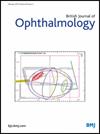Application of real-time artificial intelligence to cataract surgery
IF 3.5
2区 医学
Q1 OPHTHALMOLOGY
引用次数: 0
Abstract
Background/aims Artificial intelligence (AI) in Ophthalmology has yet to be applied to real-time cataract surgery. This work explores a new AI tool, developed for phacoemulsification, and evaluates its potential uses. First, our study aimed to demonstrate the use of AI in phase recognition and analysis of phacoemulsification. Second, to evaluate the application of real-time AI to live cataract surgery. Methods Phase I: surgical video recordings of adult patients undergoing cataract surgery at Moorfields Eye Hospital were captured. The AI, via Touch Surgery Ecosystem, was developed and used to segment surgery into phases based on the International Council of Ophthalmology-Ophthalmology Surgical Competency Assessment Rubric tool. Phase II: having demonstrated the AI’s functionality in phase I, a further group of phacoemulsification patients was recruited into a live surgery study arm. Three auxiliary screens were deployed in the operating theatres, displaying phase detection and phase relevant information in real time. Results Phase I: 192 videos were analysed between March 2020 and March 2021. Average case duration for consultants (n=68), advanced trainees (n=59) and junior trainees (n=65) was 11.18, 17.54 and 21.36 min, respectively. Efficiency benchmarks were determined using the median metric values for advanced trainee and consultant cases, respectively. Phase II: efficiency metrics for 74 cases with screen deployment and 26 without were compared. With real-time AI, consultant surgeons had a significant decrease in case duration. Conclusions We demonstrate the first use of a fully independent AI platform for analysing efficiency metrics in cataract surgery. Real-time AI has the potential to improve operative efficiency and surgical team training. Data are available upon reasonable request. All data relevant to the study are included in the article or uploaded as supplementary information.实时人工智能在白内障手术中的应用
背景/目的人工智能(AI)在眼科的实时白内障手术中尚未得到应用。这项工作探索了一种新的人工智能工具,为超声乳化术开发,并评估了其潜在用途。首先,我们的研究旨在展示人工智能在超声乳化相识别和分析中的应用。二是评估实时人工智能在白内障活体手术中的应用。方法第一期:采集在Moorfields眼科医院接受白内障手术的成年患者的手术录像。通过触摸手术生态系统开发并使用人工智能根据国际眼科理事会-眼科手术能力评估准则工具将手术划分为阶段。第二阶段:在第一阶段展示了人工智能的功能后,又招募了一组超声乳化术患者进入活体手术研究小组。在手术室部署了三个辅助屏幕,实时显示相位检测和相位相关信息。第一阶段:分析了2020年3月至2021年3月期间的192个视频。咨询师(n=68)、高级学员(n=59)和初级学员(n=65)的平均病例持续时间分别为11.18、17.54和21.36分钟。效率基准分别使用高级培训生和顾问案例的中位数度量值确定。第二阶段:比较74例有筛管部署和26例没有筛管部署的效率指标。使用实时人工智能,顾问外科医生的病例持续时间显著减少。我们首次使用完全独立的人工智能平台来分析白内障手术的效率指标。实时人工智能具有提高手术效率和外科团队培训的潜力。如有合理要求,可提供资料。所有与研究相关的数据都包含在文章中或作为补充信息上传。
本文章由计算机程序翻译,如有差异,请以英文原文为准。
求助全文
约1分钟内获得全文
求助全文
来源期刊
CiteScore
10.30
自引率
2.40%
发文量
213
审稿时长
3-6 weeks
期刊介绍:
The British Journal of Ophthalmology (BJO) is an international peer-reviewed journal for ophthalmologists and visual science specialists. BJO publishes clinical investigations, clinical observations, and clinically relevant laboratory investigations related to ophthalmology. It also provides major reviews and also publishes manuscripts covering regional issues in a global context.

 求助内容:
求助内容: 应助结果提醒方式:
应助结果提醒方式:


